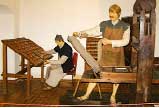August of decades and centuries past comes to life
August 1st. In 1904, a Soviet Union Hero — Frants Minkevich — was born in Minsk. During the Great Patriotic War, he was a navigator for a long-distance bombing regiment, making 87 military flights. In 1942, he took part in attacks over Berlin.
August 3rd. In 1902, USSR Hero Ilya Kozhar was born — an organiser and head of the partisan movement on the territory of the Gomel Region during the Great Patriotic War.
August 5th. In 1924, a Belarusian linguist — Arkady Zhuravsky — was born in the Tolochin District. He was a holder of the Belarusian State Award for his series of works: Skorina and Belarusian Culture.
August 6th. In 1938, a composer, an Honoured Figure of Arts of Belarus, a People’s Artiste of Belarus and the USSR — Igor Luchenok — was born
August 6th. In 1904, a Belarusian historian and a party and state figure — Timofey Gorbunov — was born in the village of Sanniki, of the Lepel District.
August 7th. In 1910, Gennady Tsitovich was born — a conductor, a Belarusian folk music expert and a choir master. He established and artistically led Belarus’ State Academic Folk Choir which bears his name now.
August 7th. In 1954, Belarusian ethnographer Tatiana Kukharenok was born in the village of Klinok, of the Cherven District.
August 1st. In 1909, a pedagogical seminary (enrolling men only) was founded in Rogachev, to operate until 1919.
August 1st. In 1914, WWI began; the territories of Belarus, Lithuania and western Ukraine fell under martial rule.
August 1st. In 1948, the Konstantin Zaslonov Museum opened in Orsha.
August 2nd. In 1927, the first issue of Rabochy (Worker) newspaper was released (now known as SB. Belarus Segodnya). August 6th. In 1517, a Belarusian enlightener and book printer — Frantsisk Skorina — published the first Bible in Old Belarusian in Prague: The Psalter. The date is considered the start of the Belarusian and Eastern Slavonic book printing.
August 6th. In 1517, a Belarusian enlightener and book printer — Frantsisk Skorina — published the first Bible in Old Belarusian in Prague: The Psalter. The date is considered the start of the Belarusian and Eastern Slavonic book printing.
August 2nd. In 1993, the Marc Chagall Museum was set up in Vitebsk.
August 2nd. In 1996, a chapel opened in Minsk’s ‘Isle of Tears’ (near the Troitsky Suburb) — becoming a monument to all Belarusian soldiers who was killed in Afghanistan.
August 3rd. In 1921, Minsk’s Special Secondary School of Police was established.
August 3rd. In 1943, a ‘rail war’ was launched in occupied Belarus which envisaged extended inactivation of railway communications in order to disorganise the enemy’s military transportation.
August 3rd. In 1944, the Pervy, Belarus and Rodina cinema houses opened.
August 4th. In 1922, Belarus’ Central Archive was founded.
August 4th. In 1945, the Yanka Kupala Literary Museum opened.
August 5th. In 1506, the Kletsk Battle took place, with the Grand Duchy of Lithuania’s 7-thousand army — commanded by Mikhail Glinsky — defeated a troop of Crimean tartars on the Lan River, near Kletsk. In 1996, a monument was erected on the battle site.
August 5th. In 1939, the first café of Belarus opened in Minsk’s Sovetskaya Street (now Nezavisimosti Avenue).
August 6th. In 1914, a Red Cross community opened a hospital (at the governor’s house) for WWI wounded soldiers — under the initiative and guidance of the governor’s wife, Mrs. Girs.
August 6th. In 1977, the first colour TV set was produced at Minsk’s Horizont Plant.
August 7th. In 1928, the first Belarusian plant of silicate brick began its operation in Klimovichi; in 1958, the Klimovichi Combine of Construction Materials was founded on its basis.
August 7th. In 1985, the village of Loshitsa was included into the city of Minsk.
Kaleidoscope of history unveiled
August of decades and centuries past comes to life












